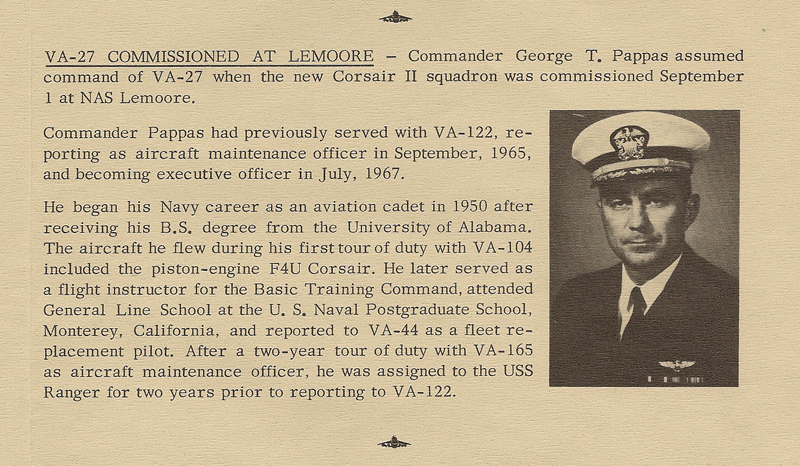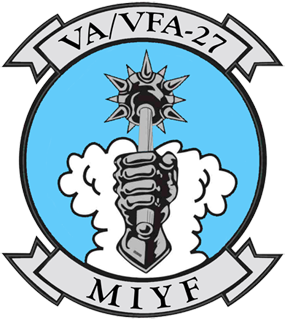

VA/VFA-27 Royal Maces



 Squadron News
Squadron News

 VFA-27 Holds Change of Command
VFA-27 Holds Change of Command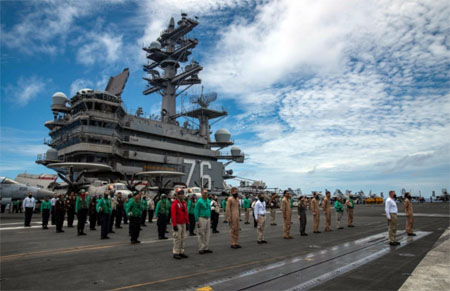
 VFA-27 Holds Change of Command
VFA-27 Holds Change of Command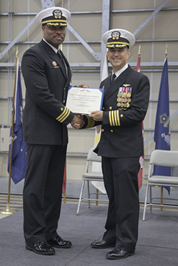
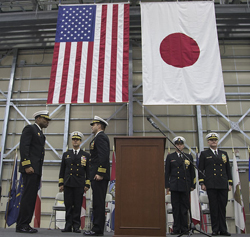
 VFA-27 Holds Airborne Change of Command
VFA-27 Holds Airborne Change of Command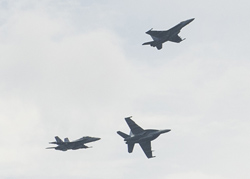
 VFA-27 Royal Maces Receive 2014 NAVAIRPAC Battle "E" Award
VFA-27 Royal Maces Receive 2014 NAVAIRPAC Battle "E" Award
 VFA-27 to Receive F/A-18 Block II Super Hornets
VFA-27 to Receive F/A-18 Block II Super Hornets
 VFA-27 'Royal Maces' Celebrate Change of Command
VFA-27 'Royal Maces' Celebrate Change of Command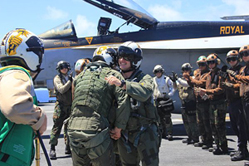
 VFA-27 'Royal Maces' Celebrate Change of Command
VFA-27 'Royal Maces' Celebrate Change of Command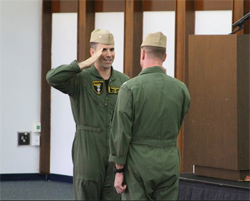
 Royal Mace Three-Peat
Royal Mace Three-Peat
 Royal Maces First CO Passes
Royal Maces First CO Passes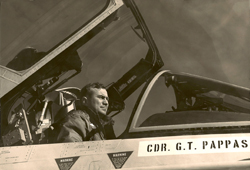
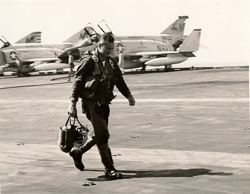
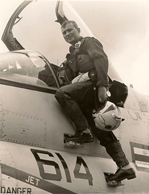
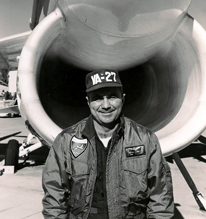
 VFA-27 'Royal Maces' Celebrate Change of Command
VFA-27 'Royal Maces' Celebrate Change of Command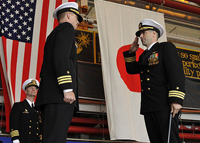
 VFA-27 Reaches Safety Milestone
VFA-27 Reaches Safety Milestone"The Royal Maces," of Carrier Air Wing (CVW) 5 have gone more than 24 years without an incident causing loss of life or permanent disability to a Sailor or damage to an aircraft exceeding $1,000,000. "I was honored to be a part of this accomplishment, but we can't take full credit as this feat stretches two decades and three different models of aircraft," said VFA-27 Executive Officer Cmdr. Fitzhugh Lee. Commander, CVW-5 Capt. Ross Myers attributes the Royal Maces' success to the dedication and professionalism of a well-run organization. "Safety is a byproduct of doing the right thing," Myers said. "Accomplishments like these only happen when everyone in the command, from the most junior Sailor to the skipper, are doing their jobs to the best of their abilities."
A significant achievement, VFA-27 kept the event low key by not holding a cake-cutting ceremony or informing the aviator who logged the 100,000th hour beforehand. "I found out it was me when I showed up to my jet and there were a bunch of photographers around," said Lt. Chris Snyder. After safely landing his F/A-18E Super Hornet aboard USS George Washington (CVN 73), Snyder said he was a benefactor of a team effort spanning almost a quarter century. "I was honored to be the one, but safety is engrained into the Royal Mace culture and my flight was just business as usual," Snyder said. Lee said the credit for the squadron's accomplishment belongs to more than the aviators who fly the aircraft; the Sailors performing maintenance, safety checks and ensuring the safe launch and recovery of aircraft deserve equal recognition. "The ones working on the flight deck and the hangar bay are the foundation of this milestone," he said. "We can't fly our planes without them." CVW-5 is the Navy's only permanently forward-deployed air wing and is currently embarked aboard GW.
The GW/CVW-5 team is currently participating in ANNUALEX 21G, a yearly, bilateral exercise between the U.S. Navy and Japan Self Defense Force. GW, commanded by Capt. David A. Lausman, is the flagship of the George Washington Carrier Strike Group (GW CSG), which is commanded by Rear Adm. Kevin M. Donegan. GW departed its forward-deployed port of Fleet Activities Yokosuka, Japan Oct. 6 on its second fall deployment as the Navy's only permanently forward-deployed carrier presence. The GW CSG consists of CVW-5, Destroyer Squadron 15 (DESRON 15), and the guided missile cruisers USS Shiloh (CG 67) and USS Cowpens (CG 63).
 VFA-27 'Royal Maces' Celebrate Change of Command
VFA-27 'Royal Maces' Celebrate Change of CommandUSS GEORGE WASHINGTON, At Sea -- The "Royal Maces" of Strike Fighter Squadron Two Seven (VFA-27) celebrated their 32nd change of command, bidding farewell to outgoing Commanding Officer Cmdr. Gregory Huffman. Royal Maces Executive Officer Cmdr. Gordon Cross assumed command of the squadron in the ceremony held aboard USS George Washington (CVN 73). Huffman served as commanding officer of the Royal Maces since August 2007. Prior to assuming command of the Royal Maces, he served as executive officer of the squadron. During Huffman's tour as executive officer and commanding officer of the Royal Maces, the squadron received both the Battle "E" award and Safety "S" award. Before arriving with the Maces, Huffman served as executive officer of the VFA-122 Flying Eagles, naval aide to the President of the United States , department head for the VFA-81 Sunliners, and flew as a junior officer with the VFA-83 Rampagers. Huffman also served as a test pilot at the Naval Weapons Test Squadron in China Lake , Calif. , after achieving a Master of Science from the University of Tennessee and a Master of Arts from the University of Maryland . He was commissioned as an officer from the U.S. Naval Academy in Annapolis , Md. in 1989. Huffman will transfer to Millington , Tenn. where he will serve as the head aviation assignments officer for Lt. Cmdrs. and junior officers.
With the change of command, Cross became the 33rd commanding officer of VFA-27. Prior to joining the Maces, Cross served as the chief of experimentation and war-gaming at U.S. Special Operations Command (USSOCOM). He also served as a department head for the VFA-86 Sidewinders, and completed his junior officer tour with the VFA-97 Warhawks. He also served as a Navy test pilot at Naval Air Station Patuxent River , Md. , and earned his Master of Aeronautics from the U.S. Navy Postgraduate School in Monterey , Calif. Cross commissioned as an officer from NROTC at the University of Michigan in 1990. Cmdr. Fitzhugh Lee is the incoming Executive Officer for the Royal Maces. Lee has previously served as the military legislative assistant to Sen. John McCain. He completed his department head tour with the VFA-22 "Fighting Redcocks" and his junior officer tour with the VFA-151 "Vigilantes." He also served as a flight instructor with the VFA-125 "Rough Riders," and he served as a landing signals officer with Carrier Air Wing 11. Lee earned a master's degree from Georgetown University and was commissioned as an officer from NROTC at the University of California at San Diego .
The VFA-27 Royal Maces are a part of Carrier Air Wing Five, permanently based in Atsugi , Japan . As part of the Forward-Deployed Naval Forces, Japan , the Royal Maces embark and fly from USS George Washington. George Washington is currently sailing off the coast of Southern California where the crew is conducting its Combat Operations Efficiency evaluation with Carrier Air Wing 5. George Washington Sailors are conducting training in the eastern Pacific Ocean before continuing to Japan , where the ship will replace USS Kitty Hawk (CV 63) as the U.S. Navy's only forward-deployed aircraft carrier.
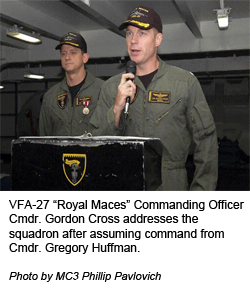
 VFA-27 begin operations aboard USS George Washington CVN-73
VFA-27 begin operations aboard USS George Washington CVN-73
 Last night trap aboard Kitty Hawk
Last night trap aboard Kitty Hawk
 First ever 100,000th carrier launch from waist CAT
First ever 100,000th carrier launch from waist CAT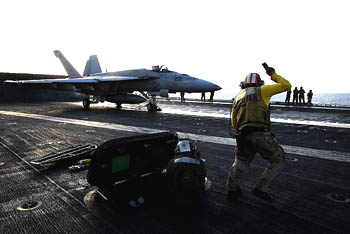
 Safety first: Maces Merit Maintenance Award
Safety first: Maces Merit Maintenance Award5/23/2007 - The Royal Mace maintainers crossed the T’s and dotted the I’s from start to finish, taking meticulous care of their squadron’s aircraft. And their hard work has paid off. The VFA-27 Royal Maces were selected as the Fiscal Year 2007 Lt j.g. Bruce Carrier Memorial Award for Maintenance and Safety Excellence winners, by Commander, Strike Fighter Wing Pacific. A total of 20 squadrons competed for the Carrier award, which is earned annually by the Pacific F/A 18 Hornet squadron which demonstrates the highest standards of maintenance, according to Lt. Manuel “Manny” Sanchez, VFA-27 Maintenance Material Control Officer (MMCO). Fighter Wing Pacific sponsors the competition each year. “The prestige of this award is well supported by the fierce level of competition among all Pacific Fleet Hornet Squadrons,” said Sanchez. The Carrier award is different from the Battle “E” in that all Pacific Fleet Hornet squadrons, regardless of platform, compete against one another, he said. The Battle “E” divides squadrons into two categories: Super Hornets (F/A-18E and F) and Legacy Hornets (F/A-18A/C/D). The Maces fly the newer F/A-18E.
“Also, the Bruce Carrier award is strictly for maintenance while the Battle “E” covers retention, operations, maintenance, readiness, etc.,” said Sanchez. The Lt j.g. Bruce Carrier award is named for an aviator who experienced a tragic set of mishaps during what should have been a routine flight. On September 15, 1975, the USS Hancock (CV-19) was conducting routine operations off the coast of the Philippines, near Subic Bay. On the last day of flight operations for Carrier Air Wing (CVW) 21, Carrier’s A-4 Skyhawk suffered hydraulic failure as he returned to the ship to land. As a result, Carrier couldn’t get the flaps of his A-4 down. It was a perilous situation, which would prove to be only the beginning of his problems.The Air Boss decided that it was too dangerous to land on board and instructed Carrier to fly to nearby NAS Cubi Point. However, Carrier then discovered that his right landing gear would not come down; he was told to return to the ship. Low on fuel, Carrier tried to make a mid-air gas run before flying back to USS Hancock. But Carrier’s fuel probe broke off, and he was left with only 500 pounds of fuel in the aircraft, making return to the ship impossible. Following the ship’s instructions, he tried to eject, but after the A-4’s canopy detached, the ejection mechanism failed, and Carrier was stuck. With everything going wrong and nothing left to do, the young aviator was told to climb as high as possible and flip upside down to bail out. Before he could do this, however, his airplane flamed out due to a lack of fuel and crashed into the ocean, killing Carrier instantly. Navy Capt. William Carrier never forgot his father’s problematic last flight, and stressed the importance of proper maintenance procedures. “No maintenance task is so small or insignificant that it does not demand 100 percent perfection in its completion. Human life can be the penalty paid for anything else,” he said.
These are words the Royal Maces live by; and are displayed on a large banner in the Royal Mace Hangar Bay, said Sanchez. “The maintainers who are behind the scenes are the ones who make it happen. Day in and day out they are performing scheduled maintenance, unscheduled maintenance, inspections and modifications; and on top of everything, they still have to keep up with their training and maintain their qualifications … but we follow the Royal Mace motto: ‘Do the right thing, the right way, for the right reasons.’”
 Air Force F-22 Raptors train with Navy F/A-18 Hornets
Air Force F-22 Raptors train with Navy F/A-18 Hornets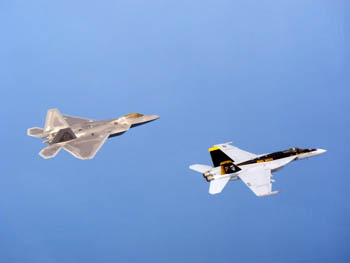
 Top Royal Mace to Become Blue Angel ‘Boss’
Top Royal Mace to Become Blue Angel ‘Boss’4/2006 - U.S. NAVAL AIR FACILITY ATSUGI, Japan (NNS) -- Cmdr. Kevin Mannix learned April 25 that he was named the 32nd commanding officer, or "Boss," of the world-famous Blue Angels flight demonstration team. The aviator will run the team throughout the 2007-2008 performance season. Mannix wrapped up his tour in Atsugi as commanding officer of Strike Fighter Squadron (VFA) 27 "Royal Maces" May 25. He and his family will leave for Florida in mid-June. After several weeks of additional training and a thorough pass down, he will take the helm of the Blue Angels in November. Mannix said he is very honored to be selected, but gives credit to many others he believes were key to his success, particularly his family, coaches, teachers, senior officers and Sailors. "I think my FDNF (Forward Deployed Naval Forces) experience with all of the community interaction is the single biggest factor in preparing me for my next assignment," he said. "Anyone should be able to achieve it if they work hard and put their heart and mind into it. If I can do it, anybody can."
The Blue Angels, considered one of the Navy's top public relations and recruiting instruments, was established at the end of World War II by then-Chief of Naval Operations (CNO) Chester W. Nimitz. In the years following, the squadron has garnered numerous accomplishments, including participation in the Korean Conflict and transition through nine aircraft to the F/A-18A and B Hornets they fly today. Along the way, the team has entertained more than 414 million fans.
"It just seemed a little overwhelming at the time," Mannix said of his feelings immediately after being selected. "This was something I didn't think I would ever be able to accomplish." The Navy started their search for the 2007-2008 season "Boss" in December 2005, when the job was announced via naval message.Mannix recalled that he didn't submit a package immediately following the initial announcement. However, after receiving a lot of encouragement from others, including a former Blue Angel team member, and with the final approval from his family, he sent in his package around mid-March. Two weeks later, he got some good news. "I was in Guam when I received the news that I was one of seven finalists," he said.
Shortly after that, Mannix and the six other finalists made their way to Naval Air Station Pensacola, Fla., to appear before an interview panel. The panel was presided over by Rear Adm. Donald P. Quinn, chief of naval air training, and six former Blue Angels. All but one were former commanding officers of the team, Mannix said. "It was an honor to be in the presence of men who have had such illustrious careers and are tasked with molding the future of Naval and Marine Corps Aviation," he said.
Mannix has amassed numerous operational and training accomplishments in his 20-year Navy career. In the past year alone, under his command, the Royal Maces received the CNO Safety Award, Battle "E" (Efficiency) award, the McClusky Award for Operational and Tactical Excellence, and the Golden Anchor award for retention excellence, among others. Aside from his professional accomplishments, Mannix and his family have enjoyed many fun times with members of the local community. "Japan has been an all-around wonderful experience for me and my family. I can't say enough good things about this great country and wonderful people who live here," he said.
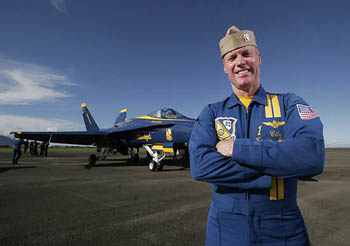
 Park's ‘Phantom’ brings back memories, history
Park's ‘Phantom’ brings back memories, history5/1/2006 - Nearly every person has seen the aircraft parked on static display near NAF Atsugi's main gate.
If these aircraft could talk, they might tell stories about the aviators who flew them, the ordnance men who readied them for combat, or the unsung heroes -- the ground crews that maintained, launched and recovered them.
Since planes can't speak for themselves, people are left to tell the tales of these historic machines, and their distinguished service in the U.S. Navy.
Frank Petrillo is one such person. And his stories involve the very same F-4 Phantom that graces the jet park near the gate. He identified the jet by its unique Bureau Number (BUNO) --155807.
The former Sailor's search for his Phantom began nearly seven months ago, when, in a wave of nostalgia, Petrillo set about the task of finding the aircraft he once knew as well as the back of his hand.
He was her plane captain three decades ago, and deployed as her caretaker with former NAS Miramar-based Fighter Squadron (VF) 92, on board USS Constellation.
After searching several F-4 websites, he located one that listed aircraft by their BUNO and last known disposition.
"The listing for '155807' didn't say 'static display;' it just said 'Atsugi Japan,'" he recalled.
Petrillo continued the search and ultimately found his aircraft.
"I know it's just an airplane, but it was like being re-united with an old friend I hadn't seen in 30-some years," he said.
Petrillo, a resident of Center Hill, Fla., has vivid memories of the jet.
"I was 18 years old, a high school dropout who picked up a little interest in working on cars when I checked in to VF 92.
My first impression was that I could not believe that this beautiful, sleek, exquisite, high performance machine I was laying my eyes on would be something I was going to be working on," said Petrillo. "I was in awe."
But the process of becoming a plane captain wasn't as simple or as quick as it sounded, he recalled.
"During the '71-'72 combat cruise on ‘Connie’ (USS Constellation) I spent six months of compartment cleaning and mess cooking as a non-rate, paying my dues."
After returning from that deployment, Petrillo was moved to VF 92's line division and began his plane captain training. It was during work-ups for a deployment in January of 1973 that F-4 BUNO 155807 was assigned to him -- something he will never forget.
"(On) the next cruise I loved working on the flight deck (as a plane captain). To this day there is not another job I would rather have," he said. "The excitement, the pace, the danger -- nothing compares to it."
Petrillo is proud of his time in the Navy and his association with VF 92, which included three full deployments aboard USS Constellation.
But Petrillo believes his experiences from long ago aren't so different from those that Sailors get today.
"Ask any airdale about his life aboard ship in a carrier-based squadron, and he'll probably tell you he could write a book," he said.
Petrillo is no longer a young, bushy-tailed plane captain. He’s a correctional officer. And the F-4 he's so proud of hasn't graced a flight deck for many, many years.
Today, the jet sits on display; a popular attraction for all who call aviation history a hobby.
Though the former shipmate hasn't seen aircraft 155807 in more years than the most junior airman has lived, the F-4 Phantom is in good hands, proudly bearing the ownership markings of the "Royal Maces" of Strike Fighter Squadron (VFA) 27, and cared for by young Sailors like Petrillo - who may one day, in a wave of nostalgia, tell part of its history.
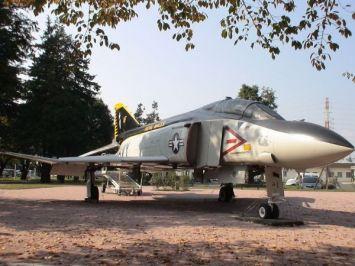
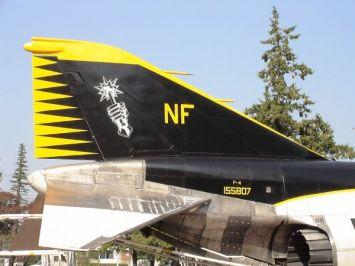
 Royal Maces Achieve Safety Milestone
Royal Maces Achieve Safety Milestone11/21/2005 -- The Sailors and pilots of Strike Fighter Squadron (VFA) 27 celebrated their 80,000th Class ‘A' mishap free flight hour Nov. 9, while deployed aboard USS Kitty Hawk (CV 63). The event represents a sustained achievement of 18 years and more than 47,000 sorties. The Royal Maces were conducting flight operations in the Sea of Japan in support of Annual Exercise (ANNUALEX) 2005 when the milestone was reached.
Cmdr. Kevin Mannix, VFA-27 commanding officer, observed the occasion by praising the contributions of his entire squadron. "This was definitely a team effort," said Mannix. "It took attention to detail, diligence and a conscious effort to promote safe operations on the part of all hands." Airborne at the time of the milestone were Lt. Cmdr. Todd Huber and Lt. Luke Babbitt. "I knew we were getting close," said Huber. "But I didn't expect it this early in the deployment. So it was a surprise when I found out."
VFA-27 operations officer, Lt. Cmdr. Tom Rich, notified the command of the monumental achievement after totaling the day's flight hours. "This is one of those achievements that everyone can take pride in," said Rich. "You can't fly this much, this safely, and for this long without the support of every single person in the squadron."
The Maces have several more weeks at sea before completing their fall underway period. The fast-paced environment of carrier-based flight operations is keeping them humble. VFA-27 safety department head, Lt. Cmdr. Will Gotten, said, "We'll take a minute to reflect on this achievement, but we can't rest on our laurels. We need to stay focused and continue to Royal Mace tradition of doing the right things, the right way, for the right reasons." VFA-27 is assigned to Carrier Air Wing Five and operates out of Atsugi, Japan. To learn more, please visit the Web Site at www.ccsg5.navy.mil.
 Royal Maces hold fly-by change of command
Royal Maces hold fly-by change of command3/10/2005 - ABOARD USS KITTY HAWK, At Sea - The "Royal Maces" of Strike Fighter Squadron (VFA) 27 held a change-of-command ceremony March 3 during an aircraft fly-by with the squadron's old and new commanding officers. Cmdr. Kevin Mannix, VFA-27's executive officer, officially took command from Cmdr. James Bynum during the fly-by, which was witnessed from the flight deck of USS Kitty Hawk (CV 63) by ship and Carrier Air Wing (CVW) 5 Sailors. "Sailors at sea are always busy, so they probably wouldn't have had the time to dress up for a formal change of command," said Bynum. "We decided to have the fly-by instead, and it is also my way of saying ‘thank you' to them."
The fly-by featured F/A-18E Super Hornets flown by Bynum and Mannix and an F/A-18F flown by Capt. Joseph Aucoin, CVW-5 commanding officer, and Cmdr. Scott Fisher, VFA-102's executive officer. All three aircraft flew past Kitty Hawk in formation after the change-of-command orders were read on the flight deck via recording by Aucoin, Bynum, and Mannix. Bynum, a native of Waco, Texas, later thanked everyone who helped make his 15-month tenure as VFA-27's commanding officer a success. "Thank you to everyone in the Kitty Hawk Strike Group for your support. You truly are the tip of the spear," he told those gathered on the flight deck via recorded message. Bynum is awaiting orders for his next duty station, but he said that no matter where he goes next, he will always have fond memories of his time with the Hawk/5 team. "You are the best in your business," he said. "Everyone has shown great comradeship, professionalism, attention to detail, and warrior spirit."
According to Aucoin, under Bynum, the Royal Maces had set the standard for the air wing with their constant drive for excellence. "They have been the top F/A-18 squadron on the ship and are one of the best in the Navy," he said. "They have been outstanding in their number of sorties and flight hours." Mannix will hopefully make a great squadron even better, said Aucoin.
"The Royal Maces never accept mediocrity," he said. "We cannot ask for a better group of leaders than the Maces have." At a reception following the fly-by, Mannix, a native of Lindenhurst, N.Y., expressed his hopes to continue the Maces' tradition of excellence. "I hope to meet all the requirements placed upon us as a squadron and to help the Kitty Hawk Strike Group meet all of its objectives. I plan to be as ready and well-trained as I possibly can," he said. At the reception, Rear Adm. Jamie Kelly, commander of Carrier Strike Group 5, took a few moments to praise Bynum's performance as VFA-27's commanding officer. "Bynum took the squadron through 75,000 flight hours and supervised the transfer of the older F/A-18C's and the welcoming of the new F/A-18E Super Hornets," said Kelly. "That is superb leadership. Wherever he goes next, Bynum will continue to be a leader in naval aviation." Kelly also had words of encouragement for Mannix. "Mannix is taking over the finest strike fighter squadron in the Navy," he said. "He'll take the squadron to even greater heights."
The Kitty Hawk Strike Group is the largest carrier strike group in the Navy and is composed of the aircraft carrier USS Kitty Hawk (CV 63), Carrier Air Wing (CVW) 5, the guided-missile cruisers USS Chancellorsville (CG 62) and USS Cowpens (CG 63), and Destroyer Squadron 15.
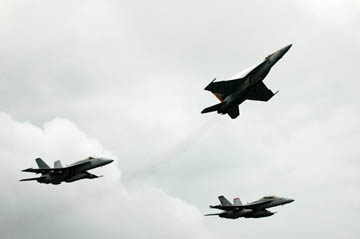
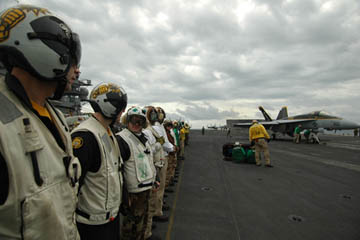
 Royal Maces Return, Ready with 'Super' Capabilities
Royal Maces Return, Ready with 'Super' Capabilities10/13/2004 ATSUGI, Japan (NNS) -- Strike Fighter Squadron (VFA) 27 returned home to Naval Air Facility Atsugi Sept. 22 after participating in the squadron's transition from the F/A-18C Hornet to the new F/A-18E Super Hornet. The training for the shift took place at Naval Air Station Lemoore, Calif., allowing members of the squadron to learn what they needed in order to maintain and operate the Super Hornets.
"The Super Hornet is a fantastic aircraft, which greatly enhances the capabilities of the air wing and the USS Kitty Hawk (CV 63) Strike Group, and we are all extremely excited about finally employing the new aircraft with all the forward deployed naval forces," said Lt. Cmdr. Todd Abrahamson, VFA-27's administration officer.
The "Royal Maces" 13 new Super Hornets serve as the full complement of the squadron's aircraft and were scheduled to arrive in multiple waves Sept. 30, but were delayed due to weather. The squadron's leadership, along with almost 40 family members, were on hand to greet the Sailors with snacks, hugs and waving hands. "After a long four months in Lemoore, it's great to be back home with Carrier Air Wing 5 and our families," Abrahamson said.
 13 Royal Maces to fly Super Hornets to Atsugi
13 Royal Maces to fly Super Hornets to AtsugiA lucky 13 Royal Maces will be flying what could be their longest mission as they pilot their brand-new Super Hornets from California to Atsugi Naval Air Facility, Japan. The squadron, also known as Strike Fighter Squadron (VFA) 27, is set to return to Japan on Thursday after four months' training on the new aircraft at Lemoore Naval Air Station, Calif. The retraining followed a decision to trade the F/A-18C Hornets the squadron had been flying for more-powerful one-seat F/A-18E Super Hornets. The jets cost $57 million each, according to the U.S. Navy Fact File. Flying back is the easiest and most efficient way to take delivery, said Lt. Cmdr. John Bernard, spokesman for the Kitty Hawk strike group, although it will be among the longest flights the aviators will make in the aircraft. During training, as well as bombing runs during war, missions typically last a few hours or less. How long it will take the aircraft to fly 5,475 air miles is unclear. It takes a commercial aircraft about eight hours. The Super Hornet's two engines deliver a top speed of more than Mach 1.8, according to GlobalSecurity.org, but the plane's increased fuel consumption when flying full throttle makes it unlikely it will travel at top speed.
The Navy declined to say when the jets are to leave California. Bernard said the aviators would land once at an undisclosed location to sleep. Also, at some points along the way, the Super Hornets will be refueled in the air from U.S. Air Force tankers. "To get that far, you've got to get a lot of gas," Bernard said. "You have to go to the big gas station, which is the Air Force."
The aviators will land at Atsugi "in waves" every few minutes, be greeted by Air Wing officials and reunite with their families. In all, some 200 aviators and support crew spent time in California to learn to fly or fix the aircraft, said Brian Naranjo, Atsugi spokesman. This will be the second squadron of Super Hornets in Carrier Air Wing 5, which flies from the deck of the USS Kitty Hawk when deployed. Last fall, the first Super Hornets - two-seaters - arrived, replacing a squadron of F-14 Tomcats and their aviators. The Tomcats, though beautiful and widely loved, were being decommissioned.
"The transition to the Super Hornet is part of a long-range plan to replace current forward-deployed naval forces units with newer, more capable aircraft," stated a Navy release. "The Super Hornet is fully capable of conducting both air-to-air and air-to-ground combat and support missions." The Super Hornet, the Navy's newest strike fighter, is 25 percent larger than its predecessor, offers increased range, greater endurance, more-powerful engines and can carry more payload, according to the Navy. It also can serve as an aerial tanker, fueling other Super Hornets, according to various reports. That will mean increased efficacy during operations because the fighter-bombers won't have to wait for the older, slower planes that traditionally have served as tankers.
In Carrier Air Wing 5, that was the S-3B Viking, flown by the Fighting Redtails of Sea Control Squadron (VS) 2. Originally designed for anti-submarine warfare during the Cold War, the Viking lost some of its macho image when it was reconfigured to primarily provide fuel. But now the Viking, nicknamed "the Hoover" because it sounds like a vacuum cleaner, is being phased out of the Navy within the next five years, according to news reports. The Fighting Redtails are to be decommissioned sometime in the next few months. "There is no plan right now to put another squadron in their place," Bernard said, "because the capabilities they have are incorporated into the Super Hornet." And because the fighter/bomber jets no longer will have to wait for their tanker to arrive, they'll be able to fly farther, faster. That, Bernard said, means "better service." The air wing still has two squadrons of Hornets.
The Royal Maces left the Kitty Hawk in May, flying their Hornets to California. That they were re-training to fly Super Hornets was an open secret for some time; it even was posted on a Navy Web site. But the Navy, concerned about necessary protocols with Japan, did not officially release the news until last month.
The Super Hornets can be a somewhat touchy subject because their added power means increased noise, and Atsugi Naval Air Facility, once remote, now sits in the middle of a populous area. The Navy has tried to ameliorate noise from aircraft operations by doing as much practice as is possible on the remote island of Iwo Jima.
 Hawk-5's Royal Maces Go Super
Hawk-5's Royal Maces Go SuperA lucky 13 Royal Maces will be flying what could be their longest mission as they pilot their brand-new Super Hornets from California to Atsugi Naval Air Facility, Japan. The squadron, also known as Strike Fighter Squadron (VFA) 27, is set to return to Japan on Thursday after four months' training on the new aircraft at Lemoore Naval Air Station, Calif. The retraining followed a decision to trade the F/A-18C Hornets the squadron had been flying for more-powerful one-seat F/A-18E Super Hornets. The jets cost $57 million each, according to the U.S. Navy Fact File. Flying back is the easiest and most efficient way to take delivery, said Lt. Cmdr. John Bernard, spokesman for the Kitty Hawk strike group, although it will be among the longest flights the aviators will make in the aircraft. During training, as well as bombing runs during war, missions typically last a few hours or less. How long it will take the aircraft to fly 5,475 air miles is unclear. It takes a commercial aircraft about eight hours. The Super Hornet's two engines deliver a top speed of more than Mach 1.8, according to GlobalSecurity.org, but the plane's increased fuel consumption when flying full throttle makes it unlikely it will travel at top speed.
The Navy declined to say when the jets are to leave California. Bernard said the aviators would land once at an undisclosed location to sleep. Also, at some points along the way, the Super Hornets will be refueled in the air from U.S. Air Force tankers. "To get that far, you've got to get a lot of gas," Bernard said. "You have to go to the big gas station, which is the Air Force." The aviators will land at Atsugi "in waves" every few minutes, be greeted by Air Wing officials and reunite with their families. In all, some 200 aviators and support crew spent time in California to learn to fly or fix the aircraft, said Brian Naranjo, Atsugi spokesman. This will be the second squadron of Super Hornets in Carrier Air Wing 5, which flies from the deck of the USS Kitty Hawk when deployed. Last fall, the first Super Hornets - two-seaters - arrived, replacing a squadron of F-14 Tomcats and their aviators. The Tomcats, though beautiful and widely loved, were being decommissioned. "The transition to the Super Hornet is part of a long-range plan to replace current forward-deployed naval forces units with newer, more capable aircraft," stated a Navy release. "The Super Hornet is fully capable of conducting both air-to-air and air-to-ground combat and support missions." The Super Hornet, the Navy's newest strike fighter, is 25 percent larger than its predecessor, offers increased range, greater endurance, more-powerful engines and can carry more payload, according to the Navy. It also can serve as an aerial tanker, fueling other Super Hornets, according to various reports. That will mean increased efficacy during operations because the fighter-bombers won't have to wait for the older, slower planes that traditionally have served as tankers.
In Carrier Air Wing 5, that was the S-3B Viking, flown by the Fighting Redtails of Sea Control Squadron (VS) 2. Originally designed for anti-submarine warfare during the Cold War, the Viking lost some of its macho image when it was reconfigured to primarily provide fuel. But now the Viking, nicknamed "the Hoover" because it sounds like a vacuum cleaner, is being phased out of the Navy within the next five years, according to news reports. The Fighting Redtails are to be decommissioned sometime in the next few months. "There is no plan right now to put another squadron in their place," Bernard said, "because the capabilities they have are incorporated into the Super Hornet." And because the fighter/bomber jets no longer will have to wait for their tanker to arrive, they'll be able to fly farther, faster. That, Bernard said, means "better service." The air wing still has two squadrons of Hornets.
The Royal Maces left the Kitty Hawk in May, flying their Hornets to California. That they were re-training to fly Super Hornets was an open secret for some time; it even was posted on a Navy Web site. But the Navy, concerned about necessary protocols with Japan, did not officially release the news until last month.
The Super Hornets can be a somewhat touchy subject because their added power means increased noise, and Atsugi Naval Air Facility, once remote, now sits in the middle of a populous area. The Navy has tried to ameliorate noise from aircraft operations by doing as much practice as is possible on the remote island of Iwo Jima.
 Royal Maces Earn FDNF 'Top Hook'
Royal Maces Earn FDNF 'Top Hook'5/11/2004 - USS KITTY HAWK, At Sea (NNS) - The "Royal Maces" of Strike Fighter Squadron (VFA) 27 were awarded their second consecutive Top Hook award April 7 as part of Carrier Air Wing (CVW) 5, for having the best landing grades in the Forward Deployed Naval Forces (FDNF) air wing. Six pilots of the squadron also earned individual honors for their ability to safely land their jets aboard the carrier. "We don't always get to see each aviator execute their mission, but we do get to see their flying skills when they make an approach and landing to the carrier," said Cmdr. Jay Bynum, VFA-27 commanding officer. Bynum, along with Lt. Cmdr. John Enfield, Lt. Cmdr. Bryan Williams and Lt. Cmdr. Todd Abrahamson, were among the air wing's top 10 pilots, while Lt. j.g. Luke Babbitt and Lt. j.g. Mike Coffey were among the top five "nuggets." Nuggets are the newest pilots within the air wing, and earning the award is considered to be a sign of success yet to come.
The Top Hook award is a competition among the fixed-wing aircraft to recover aboard the carrier in the best manner possible. Many factors go into the competition, such as how often an aircraft "bolters," which is the term used when the aircraft's tail hook misses catching any one of the four arresting wires strung across the flight deck designed to bring aircraft to a stop. "That common experience crosses the boundaries of rank, experience and aircraft type. I think that's why every naval aviator who makes the 'top 10' is extremely proud," said Bynum.
This spring under way period has been action-packed, with a healthy mix of air-to-air and air-to-ground training, and included detachments to Okinawa, participation in Exercise Foal Eagle '04, and some close-air support training at Lancelin Range in Australia. While deployed, the Royal Maces have enjoyed liberty in Hong Kong; Busan, Republic of Korea; Singapore; and Perth and Fremantle, Australia. Once they return from their current under way period this month, the Royal Maces will transfer their F/A-18C Hornets to the "Golden Dragons" of VFA-192, also part of Carrier Air Wing 5 embarked aboard USS Kitty Hawk (CV 63).
VFA-27 is assigned to Carrier Air Wing 5 and embarked aboard Kitty Hawk, operating as part of the Forward Deployed Naval Forces in Japan.
 Royal Mace Officers Get A Glimpse Of History
Royal Mace Officers Get A Glimpse Of HistoryOn the evening of 14 August 2003, the Royal Maces of VFA-27 gathered in Tokyo, Japan, to celebrate a dining out that held special meaning for the squadron. For the evening's guest speaker, squadron CO Cdr. Gary Shoman took advantage of being in a foreign country and invited LCdr. Ryoji Ohara , inset, Japan Maritime Self-Defense Force (Ret.), to attend. Throughout his WW II combat career Ohara flew several versions of the Mitsubishi A6M5 Zero. He was involved in over 100 attacks and 60 dogfights, for which he received an award for bravery. By the end of WW II only five fellow pilots of the original 60 in Ohara 's fighter squadron, the 6th Kokutai, survived. Today, Ohara is the only surviving member. Many Royal Mace aviators flew sorties in Operation Iraqi Freedom and were eager to ask Ohara about his most memorable mission. He recalled an incredible dogfight that took place on 13 May 1943 over Guadalcanal Island against a U.S. F4U Corsair. At one point in the fight his Zero sustained battle damage and caught on fire. Knowing that he would be killed if he did not react swiftly, Ohara put his aircraft into a steep dive to extinguish the flames and ultimately reengaged his opponent.
LCdr. John Enfield asked Ohara if the Zero pilots trained to specific merge game plans based on the performance of the aircraft they were engaging, or if they simply fought a specific fight based on the best characteristics of the Zero. Ohara 's response was that they tailored the fight based on the opposing aircraft. He added that Japanese pilots learned their trade from ready room discussions about tactics used during engagements. It's not surprising that similar discussions in today's ready rooms are one way that junior Hornet pilots learn keys to success against dissimilar aircraft. Perhaps the most emotional words spoken by Ohara came when asked how he dealt with being separated from his family during the war. The Japanese officer said that he was unable to return to his homeland or see his family for nearly two years. He added a sentiment felt strongly by all in attendance, stating that those with whom you serve become your family. The Royal Maces truly benefited from the words spoken that evening by LCdr. Ohara . His actions, along with his amazing life story, testify to the fact that the traits and tales of a fighter pilot transcend time and national borders.
 The Arabian Gulf - Apr. 4, 2003
The Arabian Gulf - Apr. 4, 2003While the Prowler spent about one hour over Baghdad, another Kitty Hawk pilot was one of many working farther south in the Basra area. Lieutenant Commander Mark Johnson, 35, said he was assigned to support Marine Corps units heading north. His F/A-18 Hornet attack fighter carried laser-guided 500-pound bombs but Johnson said he was not called in to drop them, apparently because US forces were not meeting resistance. "You could see in certain places we went to where there were some columns moving north. I didn't see any columns coming down south to meet them," said Johnson, of Strike Fighter Squadron 27, known as the Royal Maces. (AFP)
 Royal Mace pilot makes 500th Kitty Hawk trap
Royal Mace pilot makes 500th Kitty Hawk trapRelease Date: 12 April 2001 - When naval aviators begin flying, they keep count of how many times they launch and land aircraft on a carrier's flight deck in the hopes that one day, they can earn 1,000 or more arrested landings within their careers. As the pilots count their traps, they can see them spread out through any number of aircraft carriers, which they served on throughout their careers. But how many aviators can say they earned even half of their traps on just one aircraft carrier?
Strike Fighter Squadron (VFA) 27's Lt. Cmdr. Chris Rollins, from Whitwell, Tenn., can make that claim, because Wednesday morning at 11:06 a.m. he made his 500th arrested landing aboard USS Kitty Hawk (CV 63). Though he has approximately 600 career arrested landings, only one-sixth of those have been achieved on eight other aircraft carriers.
“Five Hundred traps in naval aviation is quite a milestone,” said Cmdr Robert McLaughlan, VFA 27's commanding officer, from Southwest Harbor, Maine. “To do it on one ship, it's the first time I've seen that in my career. That's halfway to 1,000 and once you make it to 1,000, you make it into the Naval Aviation Museum. So 500 on Kitty Hawk is a pretty impressive feat.”
Rollins joined the Navy in June 1986 and began flying in January 1987. “I joined the Navy because I wanted to serve my country and I chose aviation as the path to do it,” said Rollins, the maintenance officer for VFA 27. “I had a friend in high school who was a big aviation buff and he got me interested in it. I've always been a fan of the military and aviation seemed like an exciting and rewarding way to serve my country.” From his early flying days, he never pictured himself actually reaching this point in his career. “It was so far down the road and it sounded like such a daunting number to say you have 500 arrested landings,” Rollins said. “I never dreamed I'd end up with 500 on one ship.” He has done carrier qualification with detachments on eight other carriers, but Kitty Hawk is the only aircraft carrier he has deployed with in an operational status. “When I got to my first fleet squadron Carrier Air Wing (CVW) 15, flying the A-6 Intruder, I checked in the first day,” Rollins said. “The next day I left for Norfolk, Va., to bring Kitty Hawk out of a ship's life extension program. So I was on the first deployment the ship made, coming out of SLEP.”
Rollins has also served at various shore commands, during which he was not associated with any aircraft carriers. Then he received orders to CVW 5, forward deployed to Naval Air Station Atsugi, Japan. “When I originally knew I was coming to CVW 5, ex-USS Independence (CV 62) was out here,” Rollins said. “But the ship left before I got here, so I never got a trap on it. When I found out Kitty Hawk was relieving Independence, one of the first things I thought was that I'd be able to get significant milestones because I had 301 Kitty Hawk traps when I came here 2 ½ years ago.” Rollins still has 18 months left in his tour with the Royal Maces and he says he'll be able to get 600 traps on Kitty Hawk in that time. “I don't know if I'll get to 700,” he continued. He had the support of many people in achieving this accomplishment, but he's especially grateful to his wife. “If I had to thank one person, I'd have to thank my wife, Teresa, for all her support,” Rollins said. “I couldn't have done it without her support. My family is the biggest thing and I could not have made it without them.”
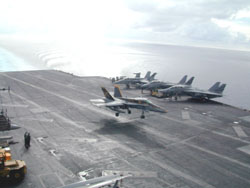
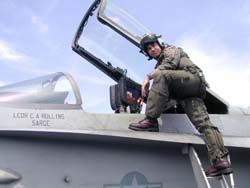
 Happy Birthday to the 'Royal' Family
Happy Birthday to the 'Royal' FamilySeptember 26, 1997 - After two days of bilateral carrier air operations in the Philippine Sea, exercise VALIANT BLITZ concluded recently. As a busy September at sea period comes to a close, The Royal Maces of Strike Fighter Squadron TWENTY SEVEN, (VFA 27) celebrate thirty years of excellence. Established in September 1967, as Attack Squadron 27, The Maces began flying the A-7 Corsair in December of that same year. During the Vietnam conflict in Southeast Asia, The Maces made cruises aboard the USS Constellation (CV 64) and USS Enterprise (CVN 65) where they amassed over 7,400 combat sorties.
In November 1979, VA-27 deployed aboard USS Coral Sea (CV 43), marking their eight Western Pacific deployment. In 1984, VA-27 joined Carrier Airwing FIFITEEN, and deployed aboard USS Carl Vinson (CVN 70). As January 1991 rolled around, the Maces were officially designated Strike Fighter Squadron 27, and transitioned to the F/A-18 Hornet. In November 1992, the new Hornet squadron deployed aboard USS Kitty Hawk (CV 63) to the Arabian Gulf in support of the multinational peace keeping force in Iraq.
The Royal Maces have continued to remain at the tip of the spear, conducting operations supporting the United Nations relief efforts in Somalia and in the Korean theater during critical UN negotiations with North Korea in June 1994. Since then, the Maces have transitioned to the newer F/A-18C and have changed their homeport to NAF Atsugi joining USS Independence (CV 62) and Carrier Airwing FIVE as their newest squadron. The maces are currently commanded by Cmdr. Vincent Shorts of Oakland, Calif.
 CNO Aviation Safety Award Nomination
CNO Aviation Safety Award NominationMarch 30, 1998 - VFA-27, currently in the Arabian Gulf aboard the aircraft carrier Independence, is proud to receive the nomination for the 1997 Chief of Naval Operations Annual Aviation Safety Award as the Navy's premier safety conscious Strike Fighter Squadron. "The ‘Royal Maces' enjoy a safety environment second to none," said Lt. Cmdr. Dennis "Smiley" Mikeska, a native of Rosenberg, Texas. "A top-to-bottom, combat readiness through safety attitude, and the strongest commitment to professional excellence, are the hallmark of VFA 27's maintenance organization and aircraft operations." Through an "all hands," dedicated effort, the squadron surpassed 11 years and 44,000 hours mishap-free.
Individual safety citations include the Commander, Naval Air Force, U. S. Pacific Fleet, Safety Pro of the Week awarded to Lt. Tim "Foamy" Ericsen for his flawless execution of emergency procedures and superb airmanship demonstrated during the main landing gear collapse of a squadron F/A-18C. This catastrophic event occurred during a night catapult takeoff aboard Independence. "Lt. Ericsen's actions saved a valuable asset and enabled investigators to identify a potential fleetwide safety issue — fatigued main landing gear trunion pins," Cmdr. Garry "Craze" Mace, VFA-27's Commanding Officer said." Ericsen was awarded the Air Medal by Commander, Naval Air Force, U.S. Pacific Fleet and the Order of Daedalians Distinguished Airmanship Award for his outstanding performance.
During 1997, the squadron displayed its "do it right the first time" attitude by safely expending 5,546 chaff/flare rounds, 10,890 pounds of forward firing ordnance, and 199 tons of heavy ordnance. This occurred during a time of increasing manpower shortages, seemingly insurmountable logistic/operational challenges, and increased technological requirements. On August 30th, the "Maces" conducted pre-deployment carrier qualification by supporting Indy in its Precision Aircraft Landing System certification. This process identified potential Fresnel lens stabilization mode errors, which enhanced the safety of the entire Air Wing. "Strike Fighter Squadron 27 lives by the philosophy that risk management is an all-hands, daily effort,"stated Lt. Cmdr. Mike "Buffy" Overson, the squadron's safety officer at the time of the inspection. "From the most junior Sailor to our most senior aviator, the "Royal Maces" strive to do the right things, the right way, for the right reasons."
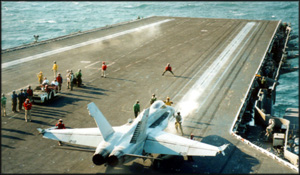
 VA-27 Royal Maces First Ever Winners of the Grampaw Pattibone Trophy
VA-27 Royal Maces First Ever Winners of the Grampaw Pattibone TrophyJanuary 15, 1986 - The Royal Maces of VA-27 became the first recipients of the Grampaw Pattibone Trophy. The annual award recognizes the individual or organization that contributed the most toward aviation safety awareness through communications. In the photo, SecNav John F. Lehman, Jr. (left) and Cdr. Joseph Sciabarra, C.O. of VA - 27 , stand beside the cast bronze trophy.
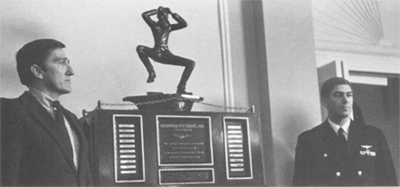
 Vietnam - 1968
Vietnam - 1968 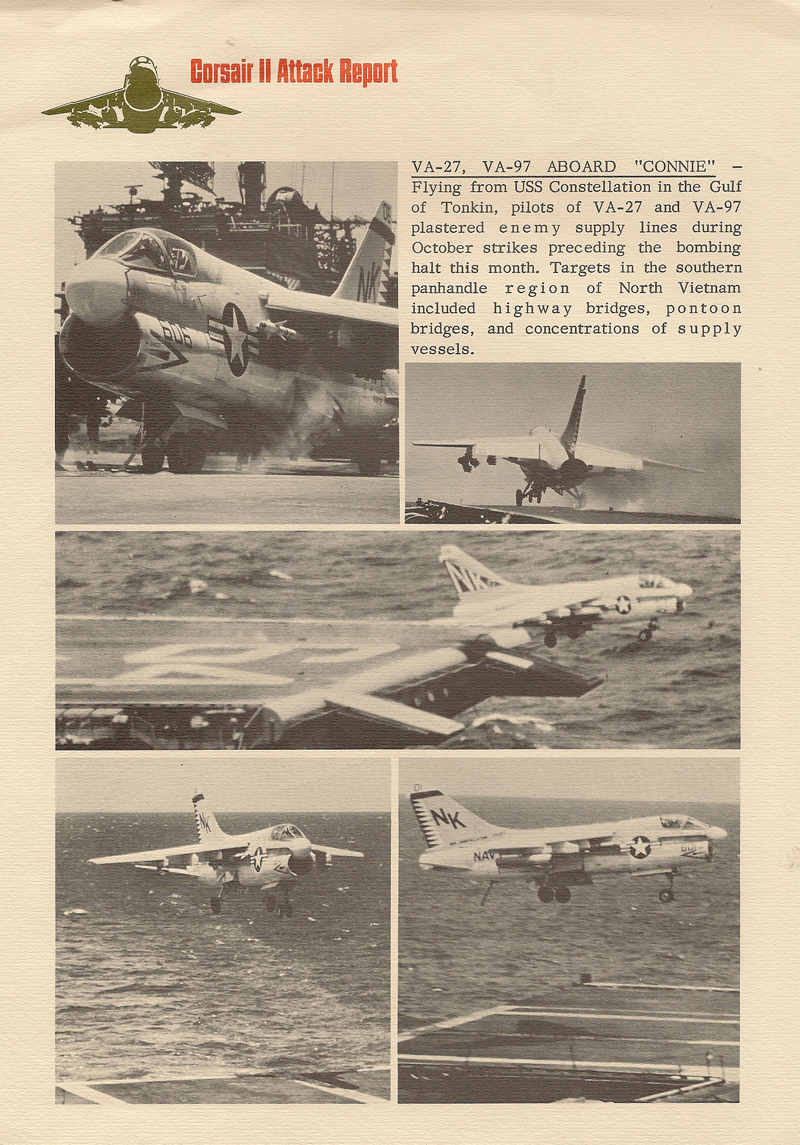
 VA-27 Commissioned - September 1, 1967
VA-27 Commissioned - September 1, 1967 